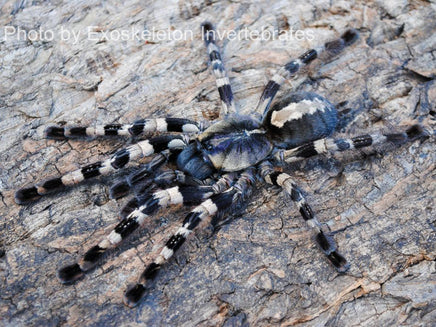
Introduction:
Meet the Poecilotheria tigrinawesseli, a true marvel in the tarantula world. Often referred to as the Wessel's Tiger Ornamental, this species is renowned for its striking appearance. It features a unique pattern of bold stripes and spots, reminiscent of a tiger's coat, which makes it a standout addition to any collection. Not only is it visually stunning, but its fascinating behavior and agility make it an endlessly interesting species to observe.
Care Details:
Temperature:
Ideal range: 75 to 85°F (24 to 29°C). Warmer environments encourage more active eating, faster growth, and quicker molting, making the care of Poecilotheria tigrinawesseli quite adaptable.
Humidity:
Specific humidity: 65-75%. It's important to maintain this range to ensure a healthy environment. While water dishes are not necessary, they are harmless if used. Personally, I choose not to use them.
Housing:
- Category: Arboreal
- Babies: Use a small vial, up to 5 inches tall and 2 inches in diameter with ventilation. Remember, I offer free vials at checkout (ask me during checkout to receive one).
- Juveniles and Adults: For individuals larger than 2 inches, a 7-8 inch tall enclosure is suitable, while adults thrive in a 12 to 16-inch enclosure.
Diet:
I feed them a varied diet of crickets and cockroaches, including Dubia, Red-runner, Lobster, and Madagascar hissing roaches. Baby tarantulas do well with baby crickets and roaches. If only one prey type is available, it's perfectly fine. For smaller prey, crush the head and leave it in the enclosure. Remember to remove uneaten food to prevent mold. As a treat, offer a pinky or hopper mouse occasionally but not as a regular diet component.
In-depth Facts:
- Latin Name: Poecilotheria tigrinawesseli
- Common Name: Wessel's Tiger Ornamental
- Locale: This species originates from India, particularly in forested regions.
- Category: Arboreal, known for its remarkable web structures.
- Size: Females can grow up to 7-8 inches, with males slightly smaller.
- Urticating Hairs: They do not possess urticating hairs.
- Growth Rate: Fast-growing, reaching maturity relatively quickly.
- Life Span: Females can live up to 12 years, while males have a shorter lifespan.
- Recommended Levels: Suitable for keepers with a bit of experience due to their speed and potent venom.
Stay Connected
- Instagram: Follow my Instagram, I'm most active here.
- YouTube: For care and education videos, check out my YouTube channel.
- Facebook: Over here I have all my reviews.
- TikTok: Visit my TikTok for additional content.
Safety Disclaimer
Experiencing a tarantula bite is an extremely rare occurrence, and it's important to note that there have been no recorded fatalities due to a tarantula bite. The venom potency varies across species, with Old World tarantulas generally having stronger venom than their New World counterparts. Within the Old World category, the Poecilotheria genus is known for having particularly potent venom.
It's crucial to approach tarantulas with respect and understanding. If you happen to get bitten, which is unlikely, the key is to stay calm. In most cases, the discomfort is superficial and subsides within a few minutes to a few hours. However, bites from species with more potent venom may result in symptoms lasting up to a week. Remember, larger tarantulas tend to have more venom than smaller ones.
Please be aware that I cannot assume responsibility for bites. Tarantula handling should be done at your own risk. In my 11 years of experience with these creatures, I have only been bitten once, by a species with highly potent venom. While the experience was painful, the symptoms had completely disappeared after a week.
Handle tarantulas responsibly, and always prioritize your safety and the well-being of the tarantula.